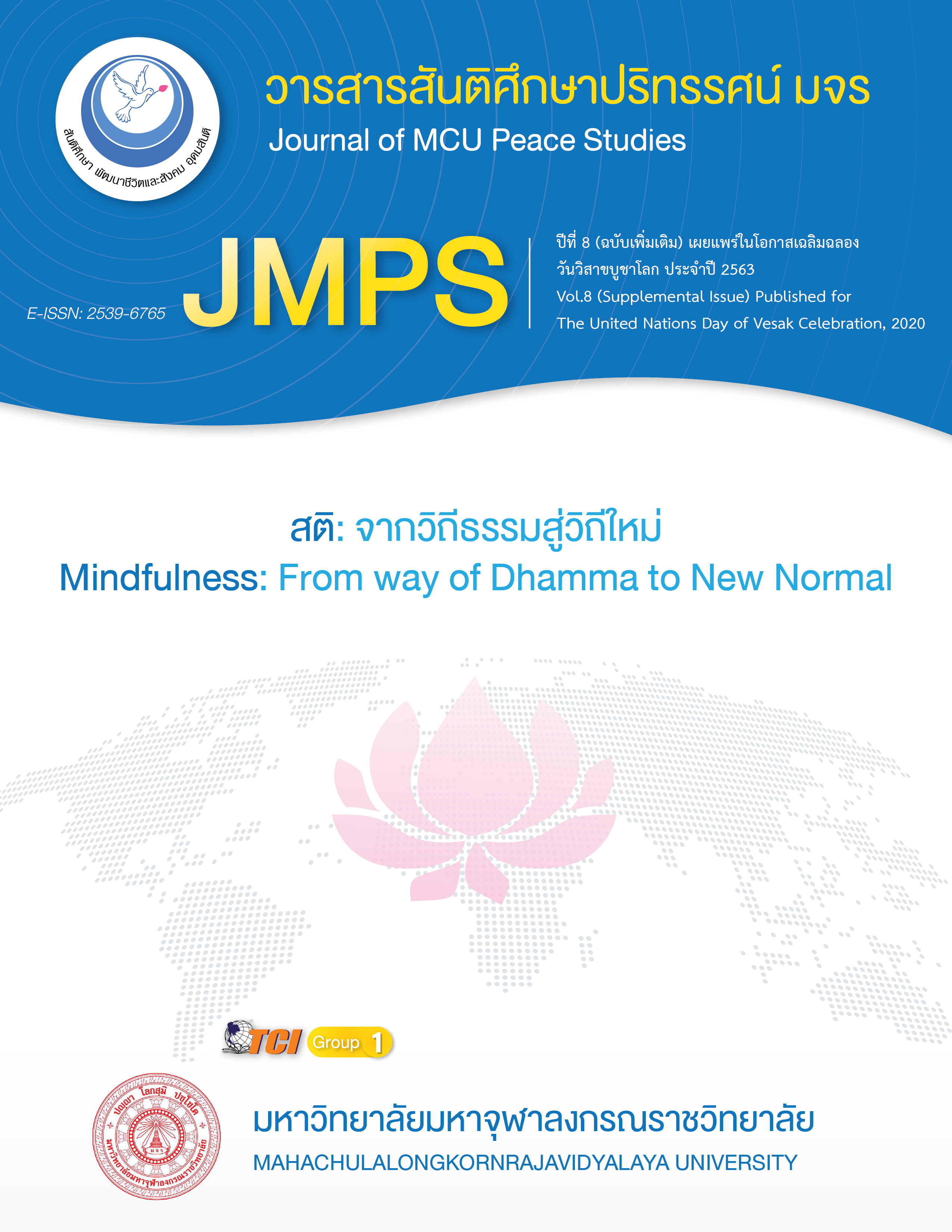5 พลังแห่งการร่วมแก้ปัญหาการรังแกผ่านโลกไซเบอร์ ของเยาวชนไทยผ่านฐานคิดทางพุทธสันติวิธี
Main Article Content
บทคัดย่อ
บทความวิชาการนี้มุ่งสะท้อนพฤติกรรมการรังแกผ่านโลกไซเบอร์ของเยาวชนไทยและนำเสนอแนวทางการแก้ปัญหาโดยอาศัยความร่วมมือของสถาบันที่แวดล้อมเยาวชน 5 สถาบัน ได้แก่ บ้าน วัด โรงเรียน ชุมชน เครือข่ายสังคมออนไลน์ ร่วมผนึกกำลังป้องกันเยาวชนจากการถูกรังแกผ่านโลกไซเบอร์และร่วมปลูกฝังความเข้าใจที่ถูกต้องเกี่ยวกับโลกไซเบอร์ จากการศึกษาเอกสารและสัมภาษณ์เชิงลึกพบว่าพฤติกรรมการรังแกผ่านโลกไซเบอร์มีหลายรูปแบบ ได้แก่ การใช้ภาพหรือข้อความภาษาที่รุนแรง การดูหมิ่นล้อเลียนจุดด้อยของผู้อื่นทั้งเรื่องรูปร่างหน้าตา ฐานะทางสังคมและความรู้ รวมถึงการทำให้สังคมรังเกียจ การบล็อกผู้อื่นออกจากกลุ่ม การตั้งกลุ่มออนไลน์นินทาผู้อื่น การล่อลวงถ่ายภาพอนาจารแล้วนำไปเผยแพร่ให้ได้รับความอับอาย
ทำให้เหยื่อเกิดอาการซึมเศร้า ไม่อยากเข้าสังคม คิดฆ่าตัวตาย บางกรณีพบว่าเหยื่ออาจตอบโต้กลับหรือกลายเป็นผู้รังแกเสียเอง โดยพฤติกรรมดังกล่าวข้างต้น เมื่อวิเคราะห์ตามหลักธรรมในพระพุทธศาสนา พบว่า สาเหตุมาจากความโลภ ความโกรธ ความหลง ความอิจฉาริษยา ทิฏฐิมานะ การไม่เคารพในตนเอง ความตระหนี่ และการดูหมิ่นผู้อื่น ส่วนพุทธสันติวิธีที่ใช้ในการแก้ปัญหา คือ หลักพรหมวิหาร 4 บนพื้นฐานของศีลและกฎแห่งการกระทำ
Article Details
ทัศนะและความคิดเห็นที่ปรากฏในบทความในวารสาร ถือเป็นความรับผิดชอบของผู้เขียนบทความนั้น และไม่ถือเป็นทัศนะและความรับผิดชอบของกองบรรณาธิการ ยินยอมว่าบทความเป็นลิขสิทธิ์ของวารสาร
References
Center for COVID-19 Situation Administration [CCSA]. (2020). COVID-19 TODAY. Retrieved April 3, 2020, from https://web.facebook.com/informationcovid19/.
Chalamvong, Y. (2017). Challenges of Thai workers in the digital age. National Institute for Thailand Development Research. Retrieved May 3, 2017, from http://tdri.or.th/2015/01/thailaborinthedigitalage>.
Charoenwanit, S. (2017). Cyber Bullying: Impacts and Preventions in Adolescents. Journal of Science and Technology, 25(4), 639-648.
Dangchamroon, A. (2020). Teacher, Department of Curriculum and Instruction, Ramkhamhaeng, University. Interview. April, 13.
Dangchamroon, A. (2020). Life skill. Bangkok: CU press.
Department of Mental Health. (2017). How to prevent children from cyberbullying. Retrieved April 9, 2020, from https://dmh.go.th/news-dmh/view.asp?id=28079.
Donegan, R. ( 2 0 12) . Bullying and Cyberbullying: History. Statistics, Law, Prevention and Analysis.The Elon Journal of Undergradute Research in Communication, 3(1), 33-42.
Foongwanich, K. (2020). graduate student, Faculty of Communication Arts, Chulalongkornmahavidyalaya University. Interview. April, 8.
Gaffney, H. & Farrington, D. (2018). International Perspectives on Cyber Bullying: Prevalence, Risk factors and Interventions. University of Cambridge. London: PalgraveMacmillan. 101-143.
Kowalski, Limber, Agatston. (2017). Cyber Bullying: Bullying in the Digital Age. Retrieved April 12, 2020, from http://www.cyberbullyhelp.com.
Mahachulalongkornrajavidyalaya University. (1996). Thai Tripitakas. Bangkok: MCU Press.
Manochanphen, N. (2019). List of countries by suicide rate in 2019. The Standard. Retrieved April 9, 2020, from https://thestandard.co/list-of-countries-by-suicide-rate-2019.
Phra Atthachart Atthajãto. (2019). The Guidelines for Problem Solving in Inappropriate Use of Facebook in Thai Youth by Buddhist Peaceful Means.Thematic Paper Master of Arts (Peace Studies). Graduate School Mahachulalongkornrajavidyalaya University.
Phra Phakphum Tikkapãnyo. (2020). Chief of Super Kids Club. Interview. April, 12.
Phrabhavanaviriyakhun (Vi.). (2009). Thai crisis recovery scripture. Bangkok: Graphic Art Printing.
Phra Brahmagunabhorn (P.A.Payutto) . (1995). Dictionary of Buddhism. Bangkok: SR printing mass product Co.Ltd.
Phramaha Hansa Dhammahãso. (2011). Buddhist Peaceful Means: Integration of principle and instrument for conflict management. Bangkok: 21 Century.
Pokaew D. (2020). graduate students, Faculty of Education: Mahachulalongkornrajavidyalaya University. Interview. April, 8.
Saejew P. (2020). Managing Director of B.T. Striker Digital Co.,Ltd. Interview. January, 5.
Samoh, N. (2017). Youth Perceptions on Cyberbullying. Journal of Behavioral Science for Development, 6(1), 351-363.
Stop Cyberbullying Thailand. (2015). Stop Cyberbullying Thailand. Retrieved April 5, 2020, from https://www.facebook.com/stopcyberbullyingthailand/.
Suchartkulwit O. (2020). Academic department of Super Kids Club. Interview. April, 10.
Surat, P. (2018). Cyber Bullying in Socio-Cultural Dimensions: Case Study of Generation Z among Thai Youths. Ph.D. Dissertation. Srinakharinwirot University.
Tripathi S. (2011). Youth Development and Adjustment. Bangkok: Jiahua.
Thai PBS. (2019). "Pressure – Bullying" Wound of Idol to painful heart. Retrieved April 9, 2020, from https://news.thaipbs.or.th/content/286434.
Tudkuea, T. (2019). Patterns, Effects and Coping with Cyber Bullying among Students of a College in the Southern Part of Thailand. Journal of Behavioral Science for Development, 11(1), 91-106.
Unicef. (2016). youth and women circumstance in Thailand. Retrieved April 9, 2020, from http://doh.hpc.go.th/data/mch/MICS5_full_th.pdf.
United state government. (2017). Digital Awareness for Parents. Retrieved May 3, 2020, from https://www.stopbullying.gov/cyberbullying/digital-awareness-for-parents.
United state government. (2017). Tips for Teachers. Retrieved May 3, 2020, from https://www.stopbullying.gov/cyberbullying/tips-for-teachers.
Wikipedia. (2012). Suicide of Amanda Todd. Retrieved April 12, 2020, from https://en.wikipedia.org/wiki/Suicide_of_Amanda_Todd.
World Health Organization. (2017). Preventing youth violence: an overview of the evidence. Retrieved April 9, 2020, from https://www.who.int/news-room/fact-sheets/detail/youth-violence.
World Health Organization. (2019). Violence against children. Retrieved April 9, 2020, from https://www.who.int/news-room/fact-sheets/detail/violence-against-children.
World health Organization. (2015). Youth Violence: The Health Sector Role in Prevention and Response. Retrieved September 2 4 , 2017 , from http://www.who.int/violence_injury_prevention/violence/youth-violence-infographic-2015.pdf?ua=1.

